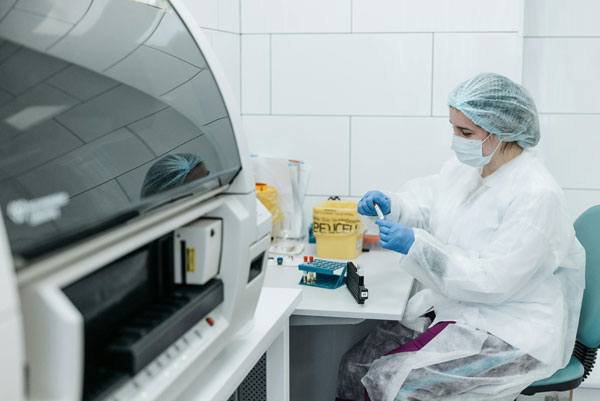Stanford’s new RNA blood test could detect cancer and hidden illnesses long before symptoms appear

[A medical professional holding a test tube sample. Photo Credit to Pexels]
Stanford researchers have devloped a new RNA-based blood test that can detect disease much earlier than ever before, potentially transforming diagnosis and treatment of various conditions.
The innovative technique published on April 21, developed by Stanford Medicine researchers led by Maximilian Diehn and the Jack, Lulu, and Sam Willson professor, examines tiny RNA fragments in blood to identify disease markers before symptoms appear.
RNA plays a crucial role in cellular function.
Think of DNA (deoxyribonucleic acid) as the body's master instruction book that stays locked safely inside the nucleus, the center of each cell.
When the body needs to do something like heal an injury or make a protein, it copies part of the DNA into a special messenger called RNA (ribonucleic acid).
One type, called mRNA (messenger RNA), carries these instructions to the parts of the cell that build proteins.
When cells die, small pieces of their DNA and RNA leak into the bloodstream whether they are healthy or not.
The Stanford scientists decided to anlayze these tiny free-floating RNAs to look for clues about what is happening inside the body.
Most cancer blood tests today search for DNA mutations.
Mutations are simply the mistakes in the genetic code that cause problems.
But Stanford’s new test looks at RNA activity instead.
This is like getting a live picture of which genes are turned on and what the cells are doing right now.
Because of this, the RNA test can sometimes find cancer even when no major DNA mutations are visible, which is important for catching cancer early, when it’s easier to treat.
In their study, the Stanford team’s RNA blood test found lung cancer in about 73% of patients, even catching many cancers in their early stages.
They focused on about 5,000 rare genes that healthy blood cells usually don't use. By narrowing it down to these special genes, they made the test much more accurate.
This RNA blood test can do more than just find cancer.
It can also catch when cancer treatments stop working because of the treatment resistance.
Sometimes, cancer cells change how they behave to survive treatment without changing their DNA.
Old tests that only look at DNA can miss this, but RNA patterns can show these changes before developing into a severe situation including advanced cancer, organ failure or tissue damage that threatens the survival.
As Dr. Alizadeh from Stanford explained, “Unfortunately, a significant fraction of our patients who are being treated for cancer go on to have their therapy stop working, and that resistance is often based on adaptations that do not involve genetic changes, but instead altering how the cells behave or even how the cells look under a microscope.” The Standford team also overcame a long-standing obstacle in RNA testing: the presence of platelets, which carry RNA that can skew results.
By blending molecular biology techniques with computational tools, researchers were able to subtract the influence of platelet RNA, allowing accurate results from both new and archived blood samples.
This opens the door for leveraging existing clinical trial biobanks to explore disease patterns and treatment responses.
Beyond cancer detection, the method also proved useful in identifying lung damage.
It detected high levels of normal lung RNA in patients with acute respiratory distress syndrome (ARDS) and showed a strong correlation between RNA levels and illness severity in COVID-19 patients.
Even healthy smokers displayed detectable lung RNA, suggesting the presence of subclinical damage.
This versatile technique not only enhances early disease detection but also maximizes the value of existing biobanks, offering a powerful tool for both clinical research and future patient care.
Of course, the RNA test is still in research stages.
It needs larger trials before hospitals start using it regularly.
But the promise is clear: decoding the body's invisible messages could transform how we diagnose and treat diseases.
Stanford’s RNA blood test is a door into a future where medicine becomes less about reacting to illness and more about predicting and preventing it before it strikes.
And it all starts with the information hidden inside a single drop of blood.

- Seunghyun Kim / Grade 11
- Trinity College School

![THE HERALD STUDENT REPORTERS [US]](/assets/images/logo_student_us.png)
![THE HERALD STUDENT REPORTERS [Canada]](/assets/images/logo_student_ca.png)
